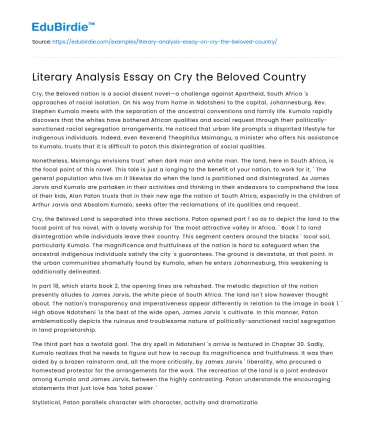Introduction
Alan Paton's "Cry, the Beloved Country," first published in 1948, is an evocative exploration of the socio-political landscape of South Africa during the era of apartheid. Through the poignant narrative of Reverend Stephen Kumalo, a rural Zulu pastor, Paton delves into the complexities of racial injustice, urban dislocation, and moral decay. The novel’s setting in pre-apartheid South Africa serves as a microcosm for the larger struggles faced by black South Africans. Paton intricately weaves themes of compassion, reconciliation, and the quest for justice, offering a narrative that is both a cry for help and a testament to human resilience. This essay seeks to analyze the novel's exploration of these themes, examining how Paton uses character development, setting, and symbolism to comment on social strife. By addressing the novel’s portrayal of the juxtaposition between rural and urban life and its representation of racial tensions, this analysis aims to highlight Paton's critical perspective on South African society.
Character Development and Social Commentary
In "Cry, the Beloved Country," Paton employs character development as a primary tool for social commentary. Reverend Stephen Kumalo's journey from the rural village of Ndotsheni to the bustling city of Johannesburg is emblematic of the broader migration patterns experienced by black South Africans. Kumalo's character serves as a lens through which the reader can witness the disintegration of tribal culture and the dislocation of individuals in the face of urbanization. As Kumalo searches for his son Absalom, who has been implicated in the murder of a white man, the narrative reveals the erosion of traditional values and the resultant moral ambiguity. Paton crafts Kumalo as a deeply empathetic character, whose personal anguish mirrors the collective suffering of his people. This individual story of loss and redemption is a powerful metaphor for the national crisis provoked by apartheid policies.
Save your time!
We can take care of your essay
- Proper editing and formatting
- Free revision, title page, and bibliography
- Flexible prices and money-back guarantee
The character of James Jarvis, the father of the murdered white man, represents another facet of Paton's social critique. Jarvis’ journey towards understanding and eventually advocating for racial justice signifies the potential for reconciliation and change. Through Jarvis, Paton illustrates that awareness and empathy can bridge the racial divide. The development of both Kumalo and Jarvis reflects Paton's belief in the necessity of personal transformation as a catalyst for societal change. This perspective is further supported by literary scholar Lewis Nkosi, who argues that Paton's characters serve as "instruments of moral purpose," driving home the imperative for reform and compassion in a fractured society.
Setting and Symbolism as Reflections of Conflict
The vivid portrayal of South Africa's landscape in "Cry, the Beloved Country" is not merely a backdrop but a vital component of Paton's narrative strategy. The contrast between the fertile valleys of Ndotsheni and the harsh urban environment of Johannesburg symbolizes the broader cultural and social dichotomies within the nation. Ndotsheni, with its lush fields and tight-knit community, represents a lost Eden, a symbol of what has been sacrificed in the name of progress and industrialization. In contrast, Johannesburg is depicted as a place of moral corruption, where the anonymity of the city exacerbates racial tensions and diminishes human connections.
Paton employs symbolism to further underscore the novel's central themes. The titular "beloved country" is a metaphor for South Africa itself, torn apart by systemic inequalities and racial strife. The land, once abundant and nurturing, has become barren and desolate, reflecting the spiritual and moral decay wrought by apartheid. The repeated imagery of the land's erosion serves as a poignant reminder of the consequences of neglecting traditional values and the environment. Scholar Peter Alexander highlights this symbolism, noting that the land's degradation parallels the "withering of the social fabric," reinforcing Paton's call for a return to compassion and communal harmony.
Counterarguments and Reconciliation
While "Cry, the Beloved Country" is lauded for its compassionate portrayal of South African society, some critics argue that Paton's work lacks a robust political stance, offering instead a somewhat idealistic view of reconciliation. Critics like Ezekiel Mphahlele have suggested that Paton's emphasis on individual transformation oversimplifies the complexities of systemic oppression. However, this perspective can be countered by acknowledging that Paton's primary goal was to humanize the struggles faced by individuals within the system, rather than providing a prescriptive political solution. By focusing on personal narratives, Paton invites readers to engage emotionally with the characters' journeys, fostering a deeper understanding of the human cost of apartheid.
Moreover, the novel's emphasis on reconciliation, as exemplified by the evolving relationship between Kumalo and Jarvis, underscores the potential for healing amidst division. This aspect of the narrative serves as both a critique of and a hopeful vision for South African society, suggesting that empathy and understanding are essential for overcoming entrenched racial divides. Paton's nuanced portrayal of reconciliation, therefore, transcends its perceived idealism, offering a realistic yet hopeful perspective on the possibility of societal change.
Conclusion
"Cry, the Beloved Country" remains a seminal work in South African literature, its themes resonating with readers across generations. Through the lens of character development, setting, and symbolism, Paton masterfully addresses the multifaceted nature of social strife under apartheid. While the novel acknowledges the deep-seated issues within South African society, it also offers a vision of hope and redemption through its portrayal of reconciliation and personal transformation. By engaging with counterarguments and exploring the nuances of Paton's narrative, this analysis highlights the enduring relevance of "Cry, the Beloved Country" as a powerful commentary on the human condition. Ultimately, Paton's work serves as a poignant reminder of the resilience of the human spirit and the enduring quest for justice and equality.






 Stuck on your essay?
Stuck on your essay?

